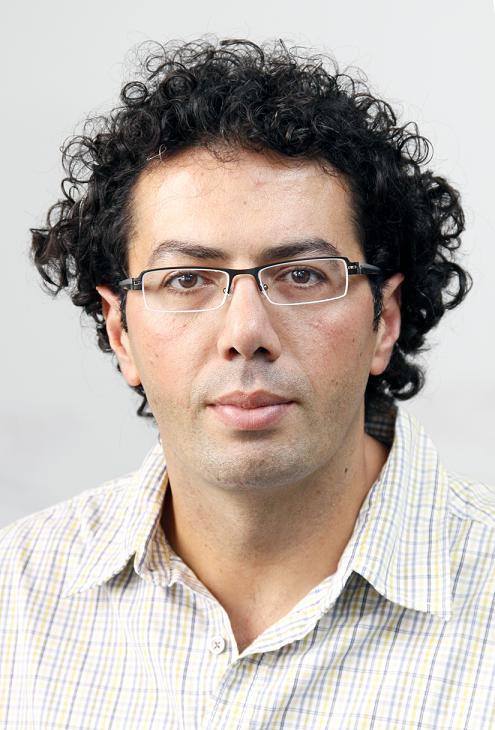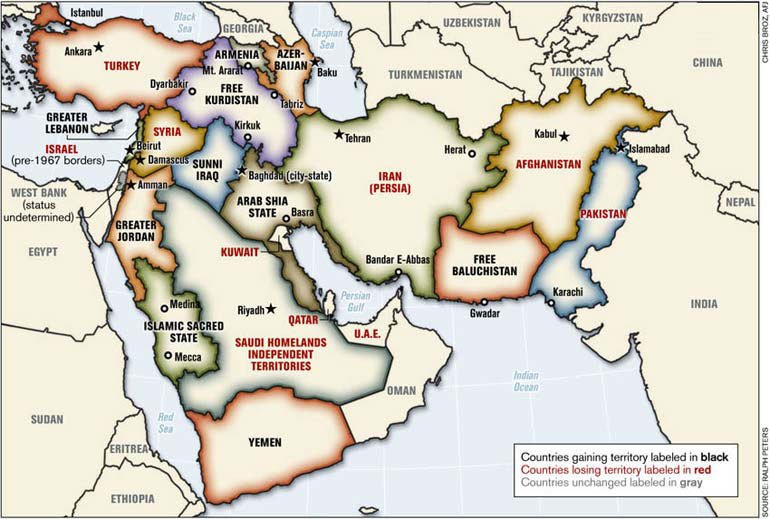www.aljazeerah.info
Opinion Editorials, March 2016
Archives
Mission & Name
Conflict Terminology
Editorials
Gaza Holocaust
Gulf War
Isdood
Islam
News
News Photos
Opinion Editorials
US Foreign Policy (Dr. El-Najjar's Articles)
www.aljazeerah.info
Division of Syria Is Part of a Grand Scheme of Dividing the Entire Middle East Into Small, Weak, and Failing States
By Ramzy Baroud

Al-Jazeerah, CCUN, March 25, 2016
Editor's Background:
 |
|
| The Israeli-Zionist plan to divide the Middle East into small, weak, and failing states, which is executed by the NATO-Russia-Iran alliance |
If Syria is to Fall, others will Follow: The Pandora’s Box of Federalism
The apparent sudden Russian military withdrawal from Syria, starting
on March 15 left political commentators puzzled.
Few of the
analyses offered should be taken seriously. There is little solid
information as of why the Russian leader decided to end his country’s
military push in Syria. The intervention, which began last September, was
enough to change the direction of the war on many fronts.
However,
one thing is for sure: the Russian withdrawal is reversible, as
indicated by Vladimir Putin himself. “If necessary, literally within a
few hours, Russia can build up its contingent in the region to a size
proportionate to the situation developing there and use the entire arsenal
of capabilities at our disposal,” he said at the Kremlin on March 17.
In fact, all parties involved are taking such a threat seriously, for the
abrupt withdrawal has not renewed the appetite for war and does not present
an opportunity for any major party in the conflict to pull out of the Geneva
peace talks.
It is safe to say that after five years of war in
Syria, the conflict is entering into a new phase. No, not a political
resolution, but a grand political game
that could divide the country into several entities, according to sectarian
lines.
If that takes place, it will bode badly,
not only for Syria alone, but the whole region. Division would then become
the buzzword according to which all current conflicts would be expected to
be settled.
While Russia’s motives behind the withdrawal are yet
to be clarified, the intrinsic link between it and the current talks, in
which dividing Syria into a federations
have been placed on the agenda, is unmistakable.
“UN mediator,
Staffan de Mistura, should be ashamed to have put ‘federalism’ on the agenda
of this week’s talks on ending the Syrian war and fashioning a ‘new’
Syria,” wrote
Michael Jensen in the Jordan Times. “Moscow, plus some Western powers,
should also be sharply criticized for thinking of such a possibility.”
Indeed, the model is not entirely Russian. The latter managed to rebalance
the conflict in favor of the government of Bashar Al-Assad, but various
other parties, western and Arab, in addition to Turkey and Iran, have also
managed to steer the conflict to a virtual deadlock.
With no goodwill involved, and little trust among the conflicting
parties, dividing the country morphed from a far-fetched possibility to an
actual one.
Therefore, it came as no surprise that, while the
Russian withdrawal was still taking place, and shortly after the resumption
of talks in Geneva, the Kurdish-controlled areas in Syria declared itself a
federal region in the north. Of, course, the
move is unconstitutional, but Syria’s violent bedlam has become the
perfect opportunity for various groups to take matters into their own hands.
After all, the very violent Daesh had carved a state for itself and
fashioned an economy, created ministries and written new text books.
But the move by the Syrian Kurdish PYD is, in fact, more consequential. ISIS
is a pariah group that is not recognized by any party in the conflict. PYD,
which is considered an offshoot of the Turkey’s Kurdistan Workers' Party
(PKK), on the other hand, has much sympathy and support, from both the US
and Russia.
The group was credited for intrepidly fighting ISIS,
and expected political dividends for that role. However, the PYD was not
invited to join the talks in Geneva.
Although their decision was
seen as a retribution for
being excluded from the talks, it is unlikely that the PYD made the
decision without covert support from its main benefactors who have been
floating the idea of federation for months.
For example, the idea
was articulated
by Michael O’Hanlon of the Brookings Institute in a Reuter’s op-ed last
October. He called for the US to find a ‘common purpose with Russia’, while
keeping in mind the ‘Bosnia model.’
More recently, during a
testimony before a US Senate committee to discuss the Syria ceasefire,
Secretary of State, John
Kerry revealed that his country is preparing a ‘Plan B” should the
ceasefire fail. It may be “too late to keep Syria as a whole, if we wait
much longer,” he said.
The Russian partaking of the war may have
altered the landscape of the conflict on the ground, but it also further
cemented the division model.
Recent comments by Russia's Deputy
Foreign Minister, Sergei Ryabkov, that a federal model for Syria "will work
to serve the task of preserving (it) as a united, secular, independent and
sovereign nation," was the Russian spin on Kerry’s remarks.
Considering the current balances of power in Syria itself and the region as
a whole, it might eventually become the only feasible solution for a country
torn by war and fatigued by endless deaths.
Qatar and other Gulf countries have already rejected the federalism
idea, although considering the Syrian government’s latest territorial
gains, their rejection might not be a pivotal factor. The
Turks also find federalism problematic for it will
empower its arch enemies, the Kurds, who, according to the model, will
be granted their own autonomous region. The PYD announcement was a trial
balloon at best, or a first step towards the division of the whole of Syria.
Considering how grisly the Syrian war has been in those past
years, federalism might not strike many as a dreadful possibility, but it
is. Arab countries are historically an outcome of western and foreign
meddling that divided the region in accordance to strategic convenience.
That ‘divide and rule’ mindset has never been vanquished, but rather
strengthened under the American occupation of Iraq.
“‘Federalism’
in the context of this region is another word for division and partition. It
is a curse word and a curse concept for countries in this region where
sectarian and ethnic communities have been planted for centuries in the
bodies of states, like raisins in a Christmas fruitcake,” Jensen elaborated.
The Arab region was divided in 1916 to resolve outstanding
conflicts between Britain, France and, to a lesser extent, Russia. The
proposed division in Syria follows the same logic.
But if this
Pandora’s Box is to open, it is likely to find itself on the agenda of
future peace talks, where Libyans and Yemenis might find themselves
contending with the same possibility. Both of these countries were, at one
point in the past, also divided so it is not entirely an implausible notion.
It is important that dividing the Arabs does not become the modus
operandi in managing conflict, the region and its resources.
Federalism does not just undermine the identity of the Syrian nation, but it
also plants the seed for further conflicts between warring sects, not in
Syria alone, but in the Middle East at large.
Only a united Syria
can offer hope for the future. Nothing else does.
– Dr. Ramzy
Baroud has been writing about the Middle East for over 20 years. He is an
internationally-syndicated columnist, a media consultant, an author of
several books and the founder of PalestineChronicle.com. His books include
‘Searching Jenin’, ‘The Second Palestinian Intifada’ and his latest ‘My
Father Was a Freedom Fighter: Gaza’s Untold Story’. His website is: www.ramzybaroud.net.
Share this article with your facebook friends
|
|
|
|
||
|
||||||


